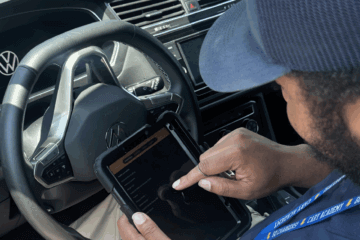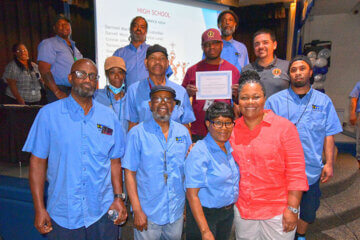Healthcare facilities have long practiced the art of the high-touch surface audit because any lapse in their cleaning regimen can have devastating consequences. During the COVID-19 pandemic, that thinking has expanded to all industries.
Schools, office buildings, retail buildings, and more are all using these audits to ensure that frequently touched items and areas are sanitized regularly.
What is a high-touch surface audit?
A high-touch surface audit is a janitorial management tool for facilities that need strict quality controls. Originally practiced primarily in healthcare, food service, and hospitality settings, the trend is now towards cleaning against viruses and harmful bacteria in all kinds of buildings.
These audits provide management with valuable data that allows them to evaluate the effectiveness of their cleaning procedures. As Mark Heller, president of Hygiene Performance Solutions, says: “In a healthcare facility, you can be brilliant at what you do Monday to Friday from 8 to 4. But if you fall down on the job Sunday at 8 pm, a germ or virus doesn’t care.”
Mark’s point has never been more true now that COVID-19 has entered the landscape. High-touch surface audits are a key tool in the fight against all viruses and germs in any facility, but especially in healthcare settings.
The high-touch surface audit inspection form available in the OrangeQC mobile app is customizable and allows the user to include notes and photos with every report.
Why perform regular inspections of these surfaces?
Try to imagine all of the surfaces in your home that are frequently touched by your family. Now consider how hard it is to keep all of these surfaces clean and disinfected just for a family of four. Now consider the number of high-touch surfaces in a single hospital room, office lobby, or classroom that need to be regularly cleaned.
This is why performing high-touch surface audits is so important. There are few better ways to discover an issue before it becomes detrimental to the health and safety of patients and staff.
The CDC is a great resource for janitorial team leaders who are compiling their list of high-touch surfaces to include in their inspection form.
Here is a few areas that they suggest be noted in your inspection form for a hospital room:
- Bed rails
- Bed frames
- Movable lamps
- Tray tables
- Bedside tables
- IV poles
- Blood-pressure cuff
Outside a healthcare environment, of course, you’ll have different line items. These will vary based on the unique requirements of your facility. A few other examples that appear in our sample high-touch audit form are:
- Door jambs
- Door surface
- Phone
- Overbed table
- Counter top
- Light switches
- Furniture
- Spot clean walls
These are just a few of the areas you should cover in your audit. Every facility is unique and will require a customized high-touch surface audit checklist.
How to perform a high-touch surface audit
As Renee Kavanagh, Environmental Services Coordinator for Mary Rutan Hospital in Ohio, says, “The best inspections are the ones that actually get done.” She uses OrangeQC software to perform her hospital’s janitorial quality control measures.
Before discovering the ease and convenience of OrangeQC, Renee used to rely on paper inspection forms that were tedious to fill out and easy to neglect. That wasn’t cutting it in such a high-risk setting. Now, she can see the results of daily high-touch surface audits and gage their effectiveness in real time. She can also use the customizable features of each inspection form and make changes as-needed.
Finally, you can train your team to use these inspection forms as a quality control tool, but also as a way to empower them to discuss issues they may be having with procedures or other individuals. Part of the purpose of a high-touch surface audit is to open a line of communication between staff and management. That way, any issues that may arise can be noted and addressed before it evolves into a bigger problem.
How often should high-touch surface audits be performed?
The answer to this question depends on the usage of the surfaces that are noted in the audit. The CDC recommends that, “more frequent cleaning and disinfection may be required based on level of use.” They also say that areas that are unused for seven or more days only require routine cleaning. So you and your janitorial team should determine the necessary frequency of the high-touch surface audits.
The important thing to remember is that you want each audit thoroughly completed. Requiring them too frequently could cause some frustration among your team members which can cause them to neglect the inspections. But requiring them not frequently enough can also have a negative impact on your quality control. Every facility is different and it is necessary to re-evaluate your cleaning procedures regularly to make sure that they are as effective as possible. This means adjusting the amount of times you require high-touch surface inspections to meet the unique needs of your building.
“Maintain and Revise” is the third step in the CDC’s guide to cleaning your facility, and it may be the most crucial part of your cleaning plan. You do not want to become stagnant in your cleaning and quality control procedures, especially in a hospital setting because the stakes are so high. With OrangeQC mobile inspection software, you can revise and customize these inspections and audits as often as is necessary.
Overtime, you will be able to notice trends in the data generated by these inspection forms. If you notice a sudden change in the data or a trend that is unsatisfactory, then this can be an indication that you need to make a change in the forms or the frequency in which they are performed.
Should you communicate results with your staff, client, or organization?
The overall goal of conducting high-touch surface audits is to make sure that your team is doing their job efficiently and to see if your cleaning procedures protect the health of patients and staff. They are also a check on the people conducting the inspections. They need be on the same page as management in regards to quality control.
You should communicate the results of each audit with your staff for two reasons. One, if they are doing a good job, then it is rewarding for them to hear positive feedback. And two, if there is an issue with procedures or a member of your team, then these inspections open a valuable line of communication that will help resolve the problem.
If you are a building service contractor, then communicating the results of these audits can prove to your clients that you are invested in quality control and interested in performing the job up to their expectations.
You can learn more about the importance of conducting audits and inspections in our Definitive Guide to Creating a Janitorial Inspection Checklist.
Download a sample audit form
We’ve created a free sample high-touch surface audit example form to get you started. (To edit the form, go to File > Make a Copy. This will create your own version of the form, which you can edit as needed.)
This is a great resource for beginning to compile a high-touch surface inspection list. Using this form as a base and then referencing the CDC lists above is a good starting point.
Using OrangeQC or another mobile inspection software to conduct these audits is a great way to improve the efficiency of your janitorial team and your quality control procedures.
Are ready to take your janitorial team to the next level with a simpler, easier, and more powerful janitorial inspection tool? Begin your free 30-day trial of OrangeQC today. (No credit card required, so you can begin right away.)



